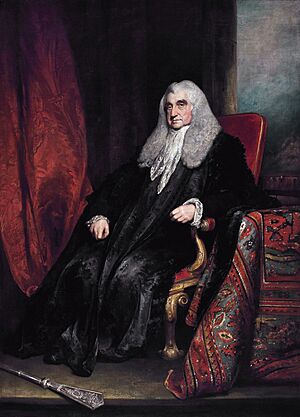William Scott, 1st Baron Stowell facts for kids

William Scott, 1st Baron Stowell (born October 17, 1745 – died January 28, 1836) was an important English judge and legal expert. He worked as the main judge for the High Court of Admiralty from 1798 to 1828. This court handled cases related to the sea, like shipping and naval matters.
Contents
Early Life and Education
William Scott was born in Heworth, a small village near Newcastle upon Tyne. His father was a businessman who transported coal. William had a younger brother, John Scott, who later became a very important legal figure called the Lord Chancellor.
William went to the Newcastle Royal Grammar School. After that, he studied at Corpus Christi College, Oxford. He earned a scholarship in 1761 and graduated in 1764. He became a tutor at University College. He was also a professor of ancient history, and people thought he was as good as the famous legal scholar Blackstone.
Even though he joined the Middle Temple (a place for lawyers) in 1762, he didn't start seriously studying law until 1776.
Becoming a Judge and Politician
William Scott earned his degree as a doctor of civil law. After a year of quiet study, he began working in courts that dealt with church laws. He quickly became very successful.
In 1783, he became a registrar, which is an official who keeps records. By 1788, he was a judge in a special court and also a top legal advisor to the government. That same year, he was made a knight, so he became Sir William Scott. In 1798, he became the main judge for the High Court of Admiralty.
Important Cases: Stopping the Slave Trade
As an Admiralty judge, William Scott heard two very important cases about stopping the slave trade.
- In 1809, a British ship caught a vessel called Donna Marianna near the Cape Coast. This ship was supposedly Portuguese, but it was actually a British ship using fake papers to trade slaves. Judge Scott agreed that the ship should be taken because it was breaking the Act for the abolition of the slave trade.
- The second case involved a French ship named Le Louis in 1816. This ship was caught trading slaves off the coast of Africa. At first, a British ship had seized Le Louis. However, Judge Scott overturned this decision. He said that British ships could not stop and search other countries' ships on the open sea unless there was a war. He believed that stopping the slave trade was important, but it should be done through international agreements, not by naval officers breaking international rules.
William Scott also got involved in politics. He tried to become a Member of Parliament for Oxford University in 1780 but didn't win. He won the seat in 1801. He also represented Downton in 1790. In 1793, he became a member of the Royal Society, a famous group for scientists.
In 1821, when George IV became king, William Scott was given a special title. He became Baron Stowell, taking his title from his estate called Stowell Park. This meant he was now a peer, a member of the nobility.
Lord Stowell retired from his judge roles. He left the church court in 1821 and the High Court of Admiralty in 1827.
Family Life
Lord Stowell was married two times. His first wife was Anna Maria Bagnall, whom he married in 1781. They lived at Erleigh Court near Reading. They had four children, but only one daughter lived longer than him.
In 1813, he married again to Louisa Catharine Howe. She was the widow of the Marquess of Sligo.
Lord Stowell passed away on January 28, 1836, at Erleigh Court. He was 90 years old. Since he had no sons who survived him, his title of Baron Stowell ended when he died.
Images for kids
-
Lord Stowell. (William Owen)


